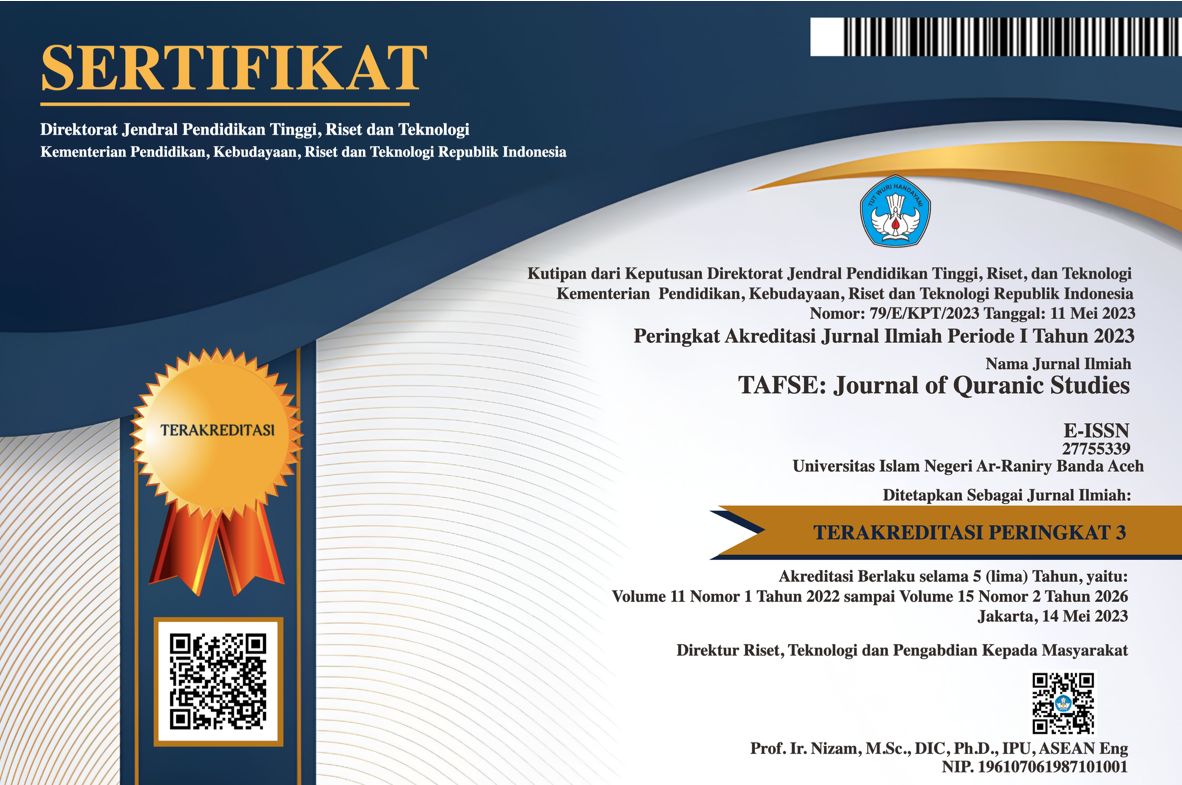Problematika Penulisan Al-Qur’an dengan Rasm Usmani pada Al-Qur’an Cetakan Indonesia dan Malaysia
DOI:
https://doi.org/10.22373/tafse.v5i1.12508Keywords:
Penulisan, Al-Qur’an, Rasm UsmaniAbstract
The Qur'an is a direct miracle of the Prophet Muhammad and the main source in Islam. Therefore, the Qur'an needs to be kept seriously, not only in understanding and interpreting it, but also in knowing the history of its descent, the form of the letters, and how the letters are formed. Rasm Usmani is Rasm al-Qur'an which has been agreed upon by the companions of the Prophet and is used as a guide and reference standard for writing the Qur'an by Muslims until now. However, there are still many prints of the Qur’an that violate Rasm Usmani. from the background of problem above, this study aims to find out how the history of the writing of the Qur'an, the background of the emergence of Rasm Usmani and the rules for writing verses of the Qur'an in Rasm Usmani. This research is a literature study with a historical approach. The results showed that the writing of the Qur'an was the sunnah of the Prophet which was followed by ijmak (agreement) by all scholars, because the writing was in the form of tauqifiyyah which was carried out under the supervision of the Prophet. Rasm Usmani is the writing of the verses of the Qur'an which was used and approved by Caliph Usman when the process of writing the Qur'an was carried out. The Uthmani Rasm has been agreed upon by the scholars, so that the Rasm must be followed in its entirety by not adding or subtracting a single letter.
Al-Qur’an merupakan mukjizat Nabi Muhammad saw. secara langsung dan sumber utama dalam Islam. Karena itu al-Qur’an perlu dijaga secara sungguh-sungguh, tidak hanya pada memahami dan menafsirkannya, tapi juga mengetahui sejarah turunnya, bentuk huruf-hurufnya, dan bagaimana bentuk hurufnya. Rasm Usmani merupakan Rasm al-Qur’an yang telah disepakati sahabat Rasulullah serta dijadikan pedoman dan standar rujukan penulisan al-Qur’an oleh kaum muslim sampai sekarang. Namun, masih terdapat banyak cetakan al-Qur’an yang menyalahi Rasm Usmani. Berangkat dari latar belakang masalah di atas, penelitian ini bertujuan untuk mengetahui bagaimana sejarah penulisan al-Qur’an, latar belakang munculnya Rasm Usmani serta kaidah-kaidah penulisan ayat-ayat al-Qur’an dalam Rasm Usmani. Penelitian ini bersifat kepustakaan dengan pendekatan historis. Hasil penelitian menunjukkan bahwa penulisan al-Qur’an adalah sunnah Rasulullah yang diikuti secara ijmak (sepakat) oleh seluruh ulama, karena penulisannya berbentuk tauqifiyyah yang dilakukan di bawah pengawasan Nabi. Rasm Usmani merupakan penulisan ayat-ayat al-Qur’an yang digunakan dan disetujui oleh Khalifah Usman ketika proses penulisan al-Qur’an dilakukan. Rasm Usmani telah disepakati para ulama, sehingga rasm itu harus diikuti secara utuh dengan tidak menambah atau mengurangi satu hurufpun.
Downloads
References
Al-Asqalani, Ibnu Hajar. Fathul Bari: Penjelasan Kitab Shahih Al-Bukhari, Terj. Amiruddin. Jakarta: Pustaka Azzam, 2008.
Al-Din, Zaki. Ringkasan Shahih Al-Bukhari, Kitab Fadhailul Qur’an. Selangor: Crescent News (KL) Sdn Bhd, 2004.
Al-Qaththan, Manna’. Mabahits Fi ’Ulum Al-Quran. Beirut: al-Syarikah al-Muttahidah al-Tawzi’, 1973.
Al-Qattan, Manna Khalil. Studi Ilmu-Ilmu Qur’an, Terj. Mudzakir AS, Cet. 14. Bogor: Pustaka Litera AntarNusa, 2011.
Amal, Taufik Adnan. Rekontruksi Sejarah Al-Qur’an. Jakarta: Pustaka Alvabet, 2005.
Ash-Shabuny, Muhammad Ali. Al-Tibyan Fi ‘Ulum Al-Qur’an, Terj. Muhammad Qodirun Nur. Jakarta: Pustaka Amani, 2001.
Baidan, Nasharuddin. Metode Penafsiran Al-Qur’an (Kajian Kritis Terhadap Ayat-Ayat Yang Beredaksi Mirip). Yogyakarta: Pustaka Pelajar, 2011.
Denfer, Ahmad Von. ’Ulum Al-Quran: An Introduction to the Sciensce of the Qoran, Terj. Ahmad Nasir Budiman. Jakarta: Rajawali, 1988.
Hisyami. Hakekat Ilmu Rasm & Ilmu Dhabthi Al-Qur’an. Bandung: Iris Press, 2009.
———. Ilmu Rasm (Pedoman Mentashih Mushaf). Banda Aceh: ArRijal Publisher, 2012.
Kadar. Studi Al-Qur’an. Jakarta: Sinar Grafika Offset, 2010.
Marzuki, Kamaluddin. ‘Ulum Al-Qur’An. Bandung: PT. Remaja Rosdakarya, 1994.
Munawwir, Ahmad Warson. Kamus Al-Munawwir. Surabaya: Pustaka Progresif, 1997.
Shihab, M.Quraish. Mukjizat Al-Qur’an (Ditinjau Dari Aspek Kebahasaan, Isyarat Ilmiah, Dan Pemberitaan Gaib. Bandung: PT. Mizan, 2007.
Sirajuddin, Masyhuri. Pengantar Ilmu Tafsir. Bandung: Angkasa, 1993.
Tsalabiy, Abd al-Fath Isma’il. Rasm Al-Quran. Mesir: Maktabah al-Nahdhah, 1960.
Downloads
Published
Issue
Section
License
Authors who publish with this journal agree to the following terms:
- Authors retain copyright and grant the journal right of first publication with the work simultaneously licensed under a Creative Commons Attribution License (CC BY NC 4.0) that allows others to share the work with an acknowledgment of the work's authorship and initial publication in this journal.
- Authors are able to enter into separate, additional contractual arrangements for the non-exclusive distribution of the journal's published version of the work (e.g., post it to an institutional repository or publish it in a book), with an acknowledgment of its initial publication in this journal.
- Authors are permitted and encouraged to post their work online (e.g., in institutional repositories or on their website) prior to and during the submission process, as it can lead to productive exchanges, as well as earlier and greater citation of published work (See The Effect of Open Access).





